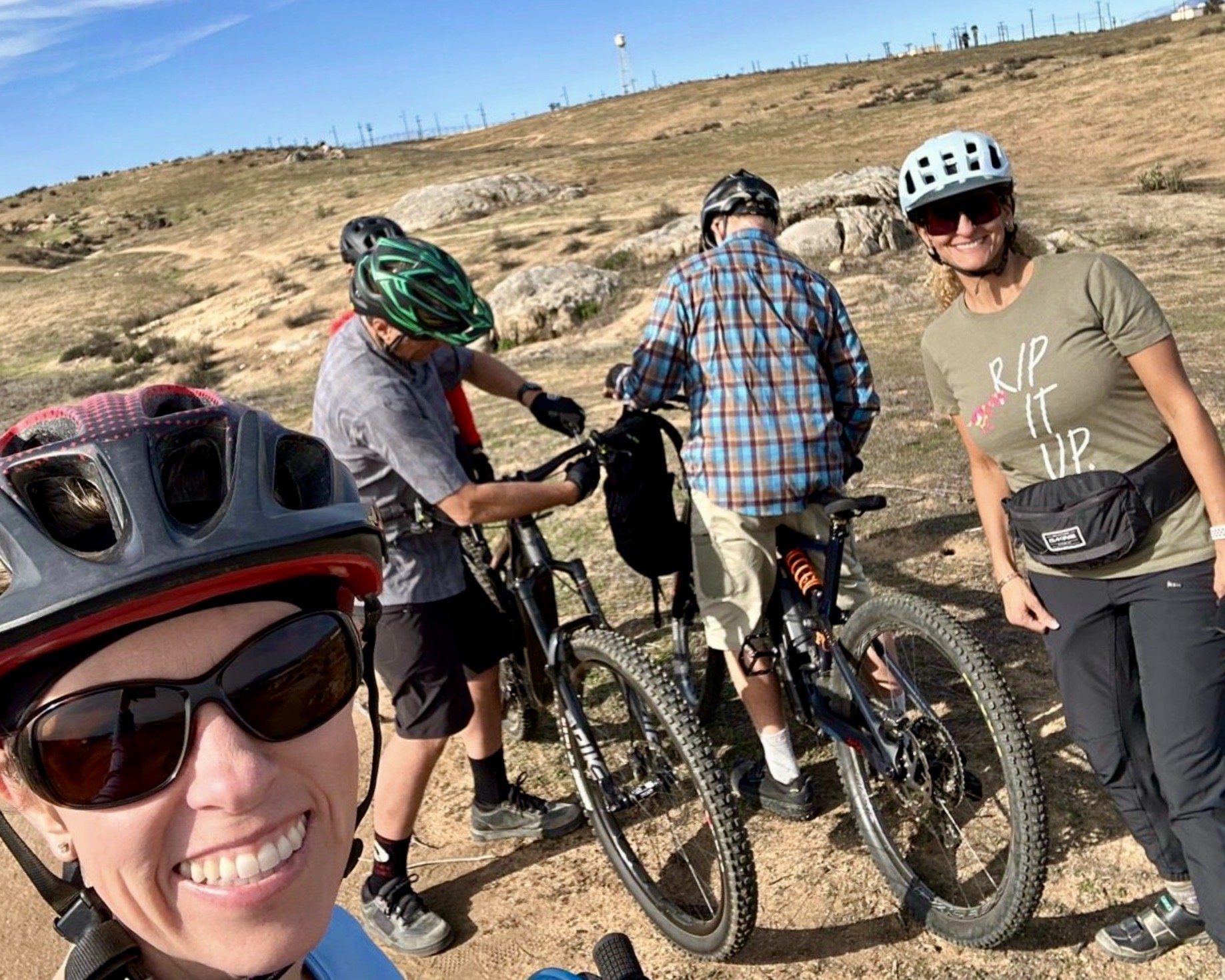Rod B.
Well-known member
Hello,
It's been a while since I've written a technical article. I thought I'd change it up and talk about what items I carry in my pack and why I carry them. Hopefully this article may give you some thought on what to carry in your own ride pack.
What I carry, may not be what you carry. Forum readers come from all over the world and we ride a variety of geographical areas and climates. Terrain, length of ride, type of bike, the mechanical skill level of the rider, all factor in to what a rider carries with them on a ride. Some people are comfortable going Commando and carry absolutely nothing. Other people pack everything, including the kitchen sink.
Who I am and the conditions I ride:
My name is Rod and I originate from Orange County, California. I'm 63 years old. Some of you may know that I had a bad accident in 2019, which resulted in the total replacement of my right ankle. Pushing a broken bike for miles up a trail is not my idea of fun.


My buddy said he spotted a Jack Ass and took the shot....

I often ride deep into the mountains and canyons. I have my ride buddies, but I often ride alone. I travel frequently throughout the USA to ride new places. More often than not, there isn't any cell phone coverage when I ride. My rides are typically about 20-28 miles long (32-45 Km) and feature 2,800 to 4,500 feet (850 - 1,370 meters) of elevation gain. Because of this style of riding, I know help won't be immediately available. I need to be self sufficient and carry a full range of lightweight repair items.
1) Trailside Issues:
What I carry in my pack address the following issues which I can reasonably anticipate may happen:
1. Tire
2. Drivetrain
3. Brake and shift lever
4. Medical
5. Personals, i.e. poo paper
6. Communication
My goal is to have a lightweight, self-sufficient pack. You want to carry tools you'll need and not everything you think you might need. Here's what you don't want. You don't want a 15 pound monstrosity that'll throw you off balance while riding and cause you to crash.
2) Trailside Hack Knowledge:
It pays to read online articles on trailside repair hacks. You can't anticipate everything, but you can be prepared for the most common breakdowns. When the times comes and a breakdown occurs, you won't be left scratching your head trying to figure out how to avoid a 15 mile walk back to the trailhead.
Here are a just a few articles on trailside hacks, there are many online:
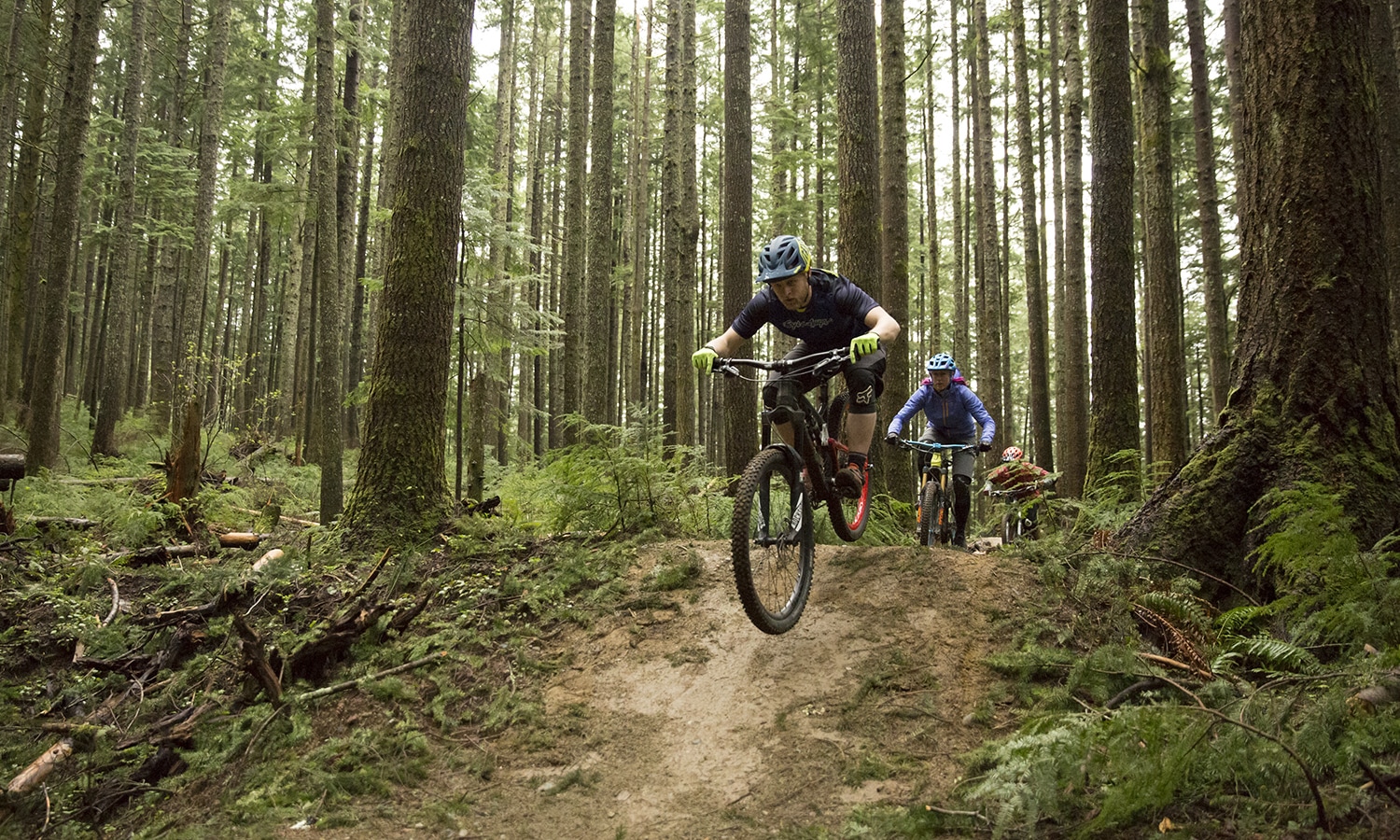

3) Backpack:
I use one of two packs. On shorter rides where weather won't be an issue, I like to use an EVOC Hip Pack 3. I like using a hip pack because it keeps my center of balance low. On longer rides where climate i.e. cold weather or rain may be an issue, I use an Osprey Syncro 12 backpack to carry my weather gear. There are many good hip and back pack designs/manufacturers out there, these two work for me.
EVOC 3 Hip Pack with bladder


Osprey Syncro 12 Backpack

4) Hygiene:
Occasionally, the call of nature happens and you need to clean up after. You may need to clean out a wound if you crash. In my pack, I carry four "Compressed Coin" tissue wipes. The compressed tissue is about the size of a coin and about 1/4" (6mm) thick. They are biodegradable and can be buried. To use the wipe, you add a small amount of water to the compressed coin tissue. The tissue expands to a 9" x 9" wet wiping cloth. They are light, take up minimal space and make very handy wet wipes. You can buy compressed coin tissues on Amazon.

5) Medical:
For medical, I carry UV lip balm, several band-aids and an extra large adhesive gauze pad. I don't take any meds, i.e. aspirin. In most instances, I'd likely be back to the trailhead before the meds can kick in. The large gauze pad is useful for those bad injuries where you need to protect a wound while riding back to the trailhead.
In the picture below, I laid my bike down on the S.A.R.T. trail and my knee landed on sharp rocks. I wasn't wearing my knee pads. The compressed coin tissue wipe helped remove the dirt and pine needles from the wound. The gauze pad helped keep the wound clean while I made the ride back to my truck. Shit happens....where your knee pads.

6) Eyesight
As I've gotten older, I can no longer see things clearly close up. I have prescription glasses for farsightedness, but I don't wear them when I ride. I had an issue with a bike and it required close up work. I couldn't see close up to make the repair. I learned from the incident and bought a pair of foldable magnifying glasses which I keep in my pack. If you suffer from poor close up vision and don't ride with prescription riding glasses, then buy a pair of these foldable reading glasses. They will save your ass if you need to see, read, or fix something close up.

7) Bike Tools
I carry the following OneUp tools either mounted on my Rise or in my hip pack:
OneUp's "EDC" tools are very light, designed exceptionally well and work. I use the OneUp "EDC Threadless" tool carrier with EDC multi tool and tire plug system on my Rise. The threadless tool carrier inserts inside the fork steerer tube and threads into a plate mounted outside on the bottom of the fork crown. The threadless carrier holds the EDC multi tool and tire plug system. You must remove the star-fangled nut from inside the fork steerer tube to use the threadless carrier.
Cross section depicting the OneUp threadless carrier mounted inside a fork steerer tube.

The EDC tool itself mounts inside the threadless carrier.

EDC multi tool, chain breaker and tire plug system

EDC chain breaker

If you have ever struggled trailside with disconnecting or connecting a quick link, then you know it can sometimes be a difficult task. OneUp's lightweight and compact chain plier works like a charm to quickly disconnect or connect quick links.

Your most frequent trailside repair will be a flat tire or loss of inflation due to burping a tire. I dislike carrying just a Co2 inflator or just a hand pump. If you have large volume tires, you may encounter a situation where you cannot get the tire bead to seat on the rim using a hand pump. The use of a Co2 canister can help seat the tire. There have been occasions were I ran out of Co2. I've learned from past experience and now carry both systems with me.
I like the OneUp mini pump, it has a dual Co2 and pump inflation feature which won't take 200 strokes and loss of life due to heat stroke to inflate the tire. The pump also allows storage of a spare Co2 cartridge inside the pump.

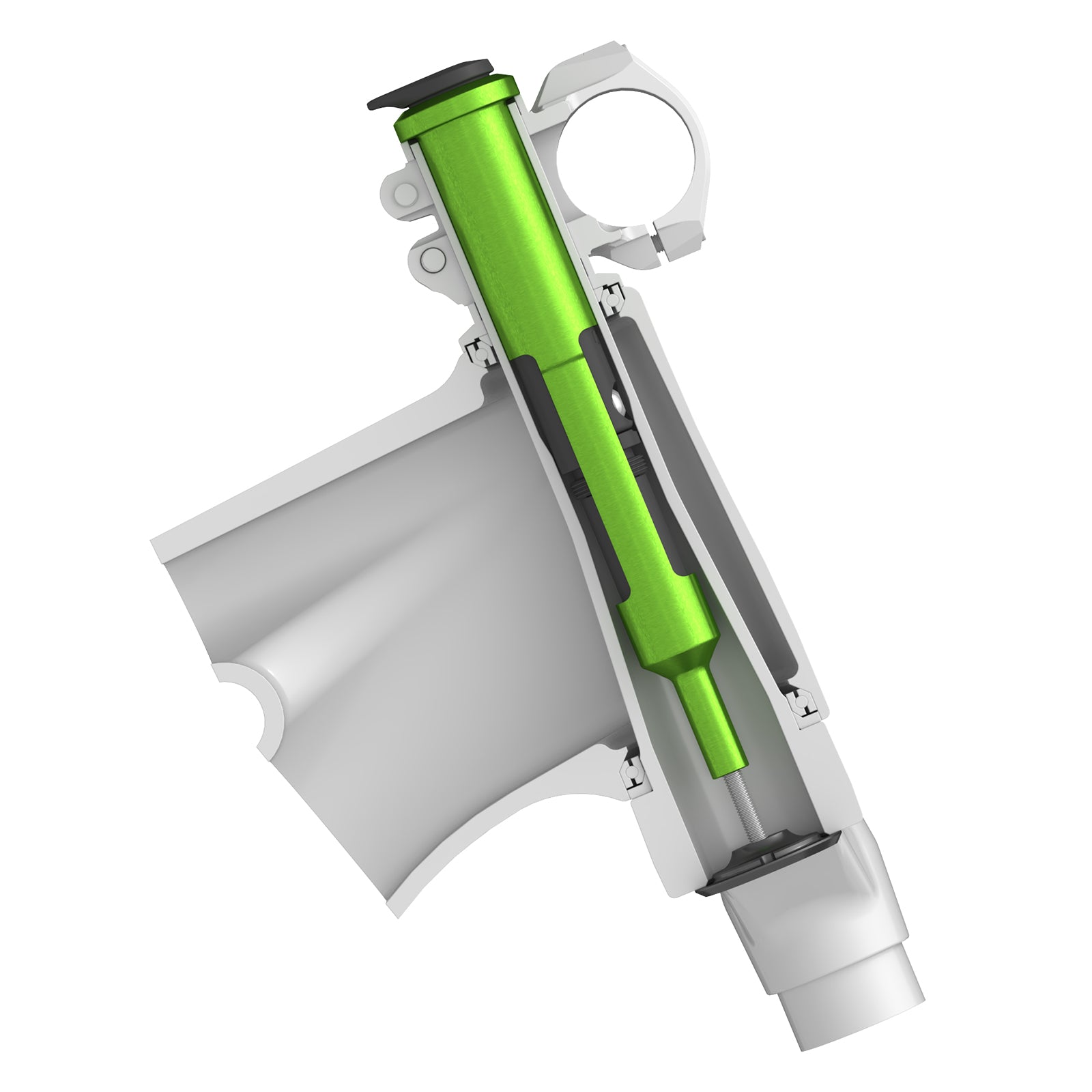
 www.oneupcomponents.com
www.oneupcomponents.com
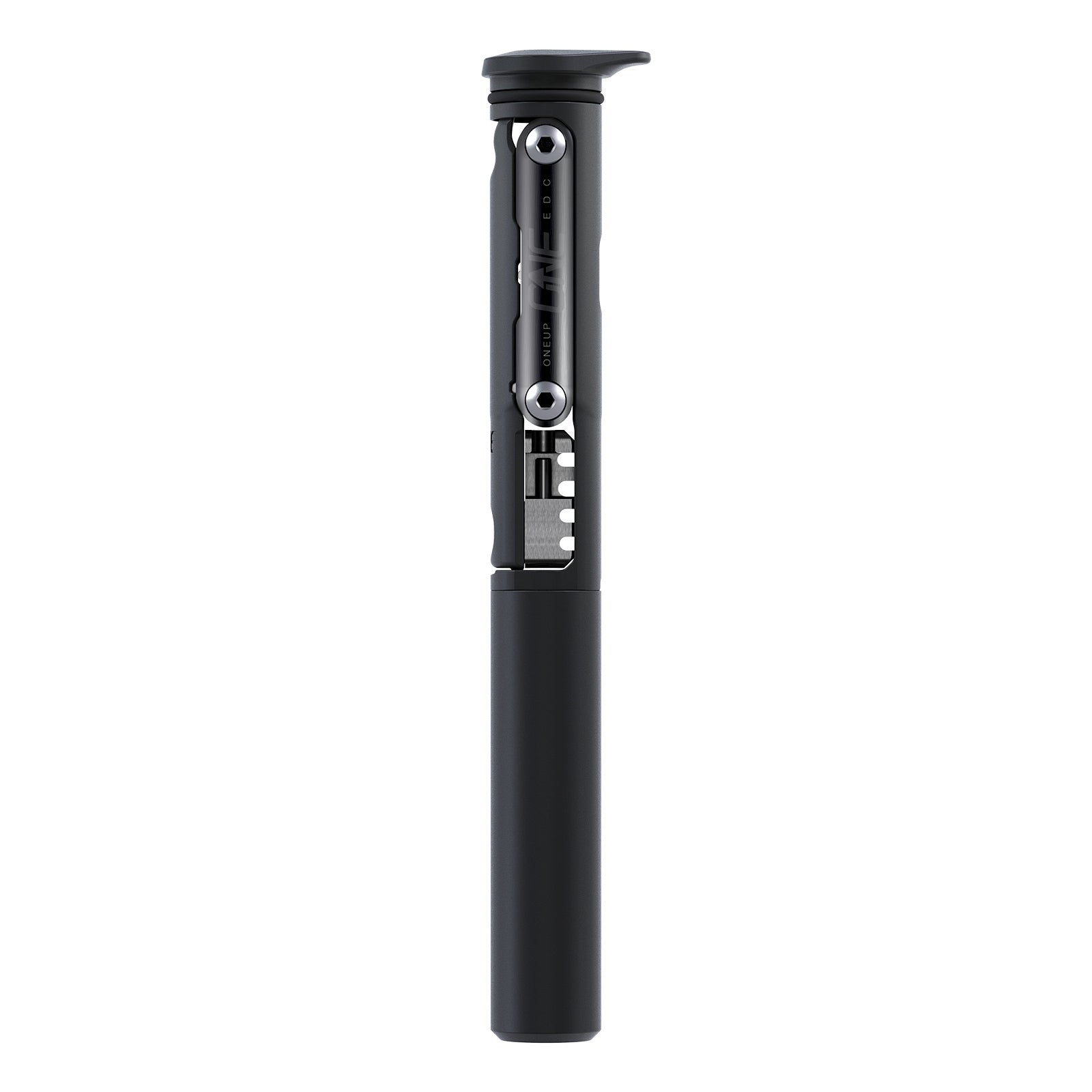
 www.oneupcomponents.com
www.oneupcomponents.com
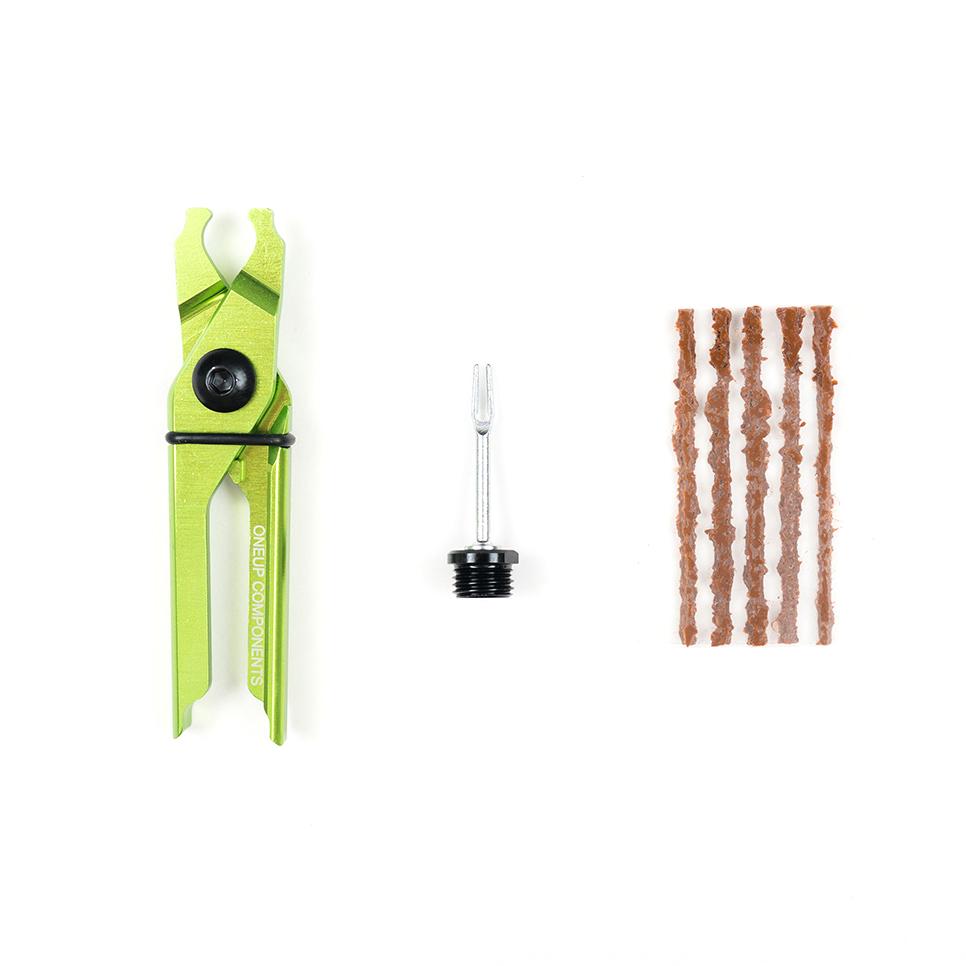
 www.oneupcomponents.com
www.oneupcomponents.com
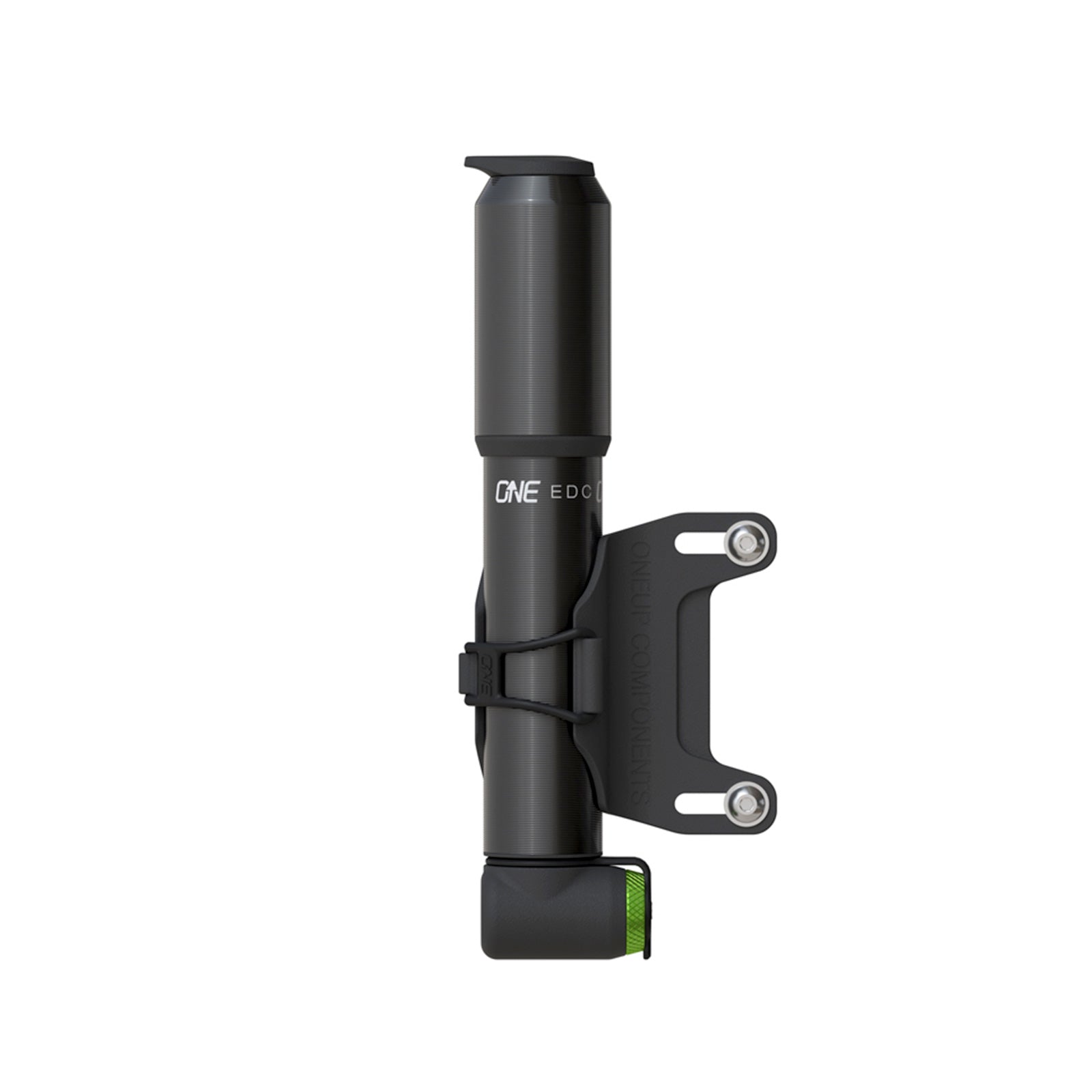
 www.oneupcomponents.com
www.oneupcomponents.com
8) Leatherman Pliers:
Leatherman makes the ultra small "Squirt PS4" multi tool. The tool is two inches (50mm) long and contains pliers and other utensils. I've lost count of how many times this tool has bailed someone out on the trail. It's been used to straighten out a bent derailleur hanger or tweak the bent lip on a rim that's hit a square edge rock and will no longer hold air. The tool is exceptionally small but also very strong.
Leatherman Squirt PS4


2018, Las Vegas Nevada, on the Ike's Peek - Menny Thanks Trail. My buddy hit a rock and bent the lip on the rear wheel. It would not hold air. In the picture he's using my PS4 Leatherman to straighten out the dinger on his rear rim.
Evidently, I was going through a "Men in Black" wardrobe phase as evidenced by the picture.

9) Tire Repair
When I first got my Rise M20, advertising said it was tubeless ready. I assumed it was. I took my bike on it's maiden voyage to Chino Hills State Park. I double flatted while deep in Water Canyon. Water Canyon is filled with goat's head thorns. I couldn't understand how I had double flatted, the wheels were setup tubeless. When I checked the tires, I discovered both wheels had inner tubes. WTF.....my bad, never assume....
I carry an ultralight "Tubolito" inner tube in my pack. If you split a tire casing, an inner tube with creative plugging can be used to get you back to your car. I like using the 45 gram Tubolito because it folds up compactly and is much lighter than a traditional rubber tube.
Tubolito 29" tube, all 45 grams.

I removed the Rise's rear inner tube and replaced it with the Tubolito. I inspected the front inner tube and discovered it had 12 punctures. I carry three types of patch kits in my pack, Park Tool GP-2 self adhesive type, Park Tool VP-1 glue type and Park Tool TB-2 large "Boot" type patch. I was able to patch the holes in the tube well enough to make it back to my truck with a slow leak and no walking.
Redundancy can be a good thing. Each type of patch I carry serves a purpose. The GP-2 self adhesive patches work on Tubolito "Thermoplastic" style tubes. They also work on rubber tubes, but getting them to stick can be difficult in dirty or wet conditions. VP-1 glue type patches work well on rubber inner tubes. TB-2 boot patches are used to patch larger holes or cuts in the tire casing which tire sealant cannot seal. The TB-2 self adhesive patch is placed on the inside of the tire casing and covers the cut. An inner tube is used to hold the boot in place. The boot prevents your emergency tube from protruding out of the cut and puncturing.
I also keep a 5" x 5" (127mm x 127mm) square sheet of thin plastic cut from a plastic milk jug in my backpack. If I suffer a sidewall cut and the TB-2 boot is too small to cover the cut, I can place the flexible milk jug plastic inside the tire to cover the cut. The plastic square is held in place by the emergency tube and prevents the inner tube from protruding out of the sidewall cut. It's a lightweight backup solution.
Park Tool GP-2 self adhesive patch kit

Park Tool - VP1 glue type patches

Park Tool TB-2, large tire boot patch

10) Zip Ties:
I carry several small and medium cable ties in my pack. Small ties can be used to help close up a sidewall cut or secure a lose item. Medium cable ties can be used to secure a crank arm to a bike, fix a broken seat, or secure a broken brake lever clamp housing to a handlebar. If you experience a stripped freehub driver, you can cable tie the cassette directly to the rear wheel spokes. This will allow you to pedal back to your vehicle.

11) Drive Train:
Occasionally, I will break a chain. This usually happens when I get caught on a punchy climb and I'm in the wrong gear and try to muscle it up the climb. In my pack, I carry four quick links and a five inch long section of 12 speed chain. I can fix almost any situation of chain breakage with this combination of parts.
If it's a clean break, a single quick link can fix the problem. More often than not however, several links adjacent to the break will bend. The bent links will need to be removed for the chain to work correctly. A severely shortened chain poses a problem. If you shift to a large cassette cog with a short chain, this will cause the derailleur arm to extend horizontally beyond it's design limits. This will either break the arm and or, the derailleur cog. With four quick links and spare section of chain, you can repair just about any length of chain damage and still be able to shift into a large cassette cog to make a climb and get back home.


12) Miscellaneous Items:
My buddies and I were riding Downieville, California. While waiting for the shuttle, I borrowed a floor pump to add air to my tires. When the shuttle reached Packer Saddle and I retrieved my bike, I discovered my front tire was flat. I checked the valve stem and saw that the floor pump had bent my valve stem core and it would not seal. I tried to straighten out the valve core and it broke. Fortunately, I carry a spare valve core in my pack. You never know when a stray rock or floor pump will take out your valve core. They're small and weigh nothing, it's cheap insurance.

I often ride trails with lots of exposure. How would you go about getting your bike back up onto a trail should you go off on a steep and loose mountain side? I'm guessing it would be a difficult task given the weight of an eBike. I carrying a 20 ft. length of 2mm Dyneema line which can handle 400 lbs/200 Kg. My thought is I could climb back up onto the trail and then pull the bike up. The rope weighs nothing and can be used for other repair purposes. Hopefully I will never have to use it.

I now have SRAM AXS on my Rise and don't have need for a shift cable. Before AXS however, I would carry a spare derailleur cable in my pack. I've never had to use it on my bike. If you pay attention to your drive train, it's one of those things you will never need. I did however use it on a buddy's bike when his shift cable snapped. I got a free Guinness out of the deal. Everybody was happy.

I keep a roll of mini duct tape, 2" x 50" (50mm x 1270mm) in my pack. I got the small roll from a SOL Mini Duct Tape kit purchased on Amazon. Duct tape has many trail uses, i.e. tire patch, band-aid, hold together a broken handlebar that's been joined back together using a branch, you name it. Keep a small roll in your pack.

If you ride in really remote areas with no cellular coverage, you may want to consider investing in an emergency locator beacon. The Garmin InReach Mini is an excellent example of such a device. The InReach allows you to communicate by way of satellite and text messaging to emergency services and family/friends. No cellular service is needed to use the device. With the InReach, you can text the nature of your emergency to emergency services or simply text the wife to let her know you are running late out on the trail. Emergency services is able to pinpoint your location via the device and GPS. The InReach requires a subscription service.
Recently my InReach was stolen from my truck...along with my hip pack. That so F'n hurt.... I've not replaced my Garmin InReach. I'm waiting for the new Apple iPhone 14 to come out. It will have satellite SOS capability.
 discover.garmin.com
discover.garmin.com
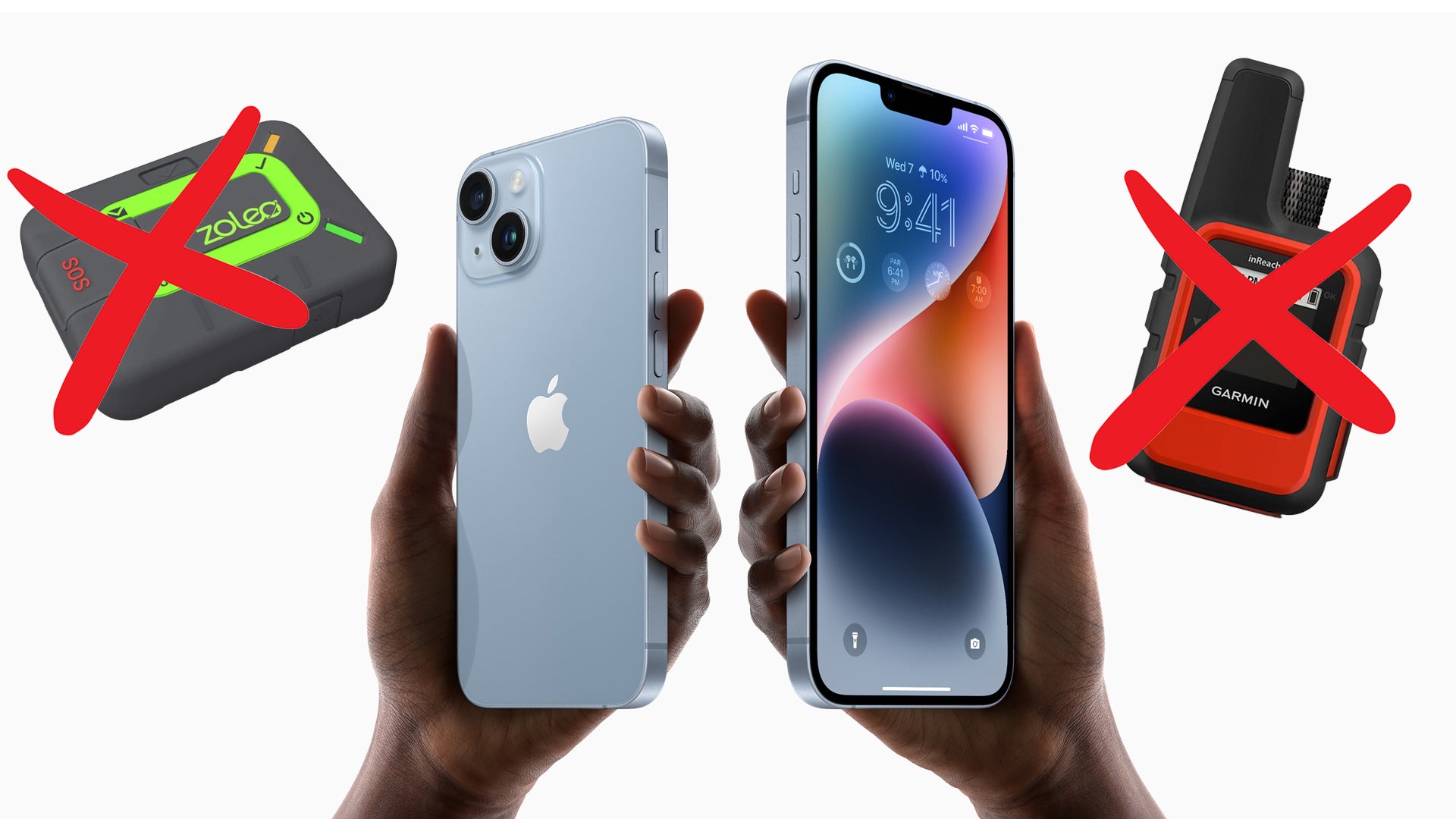
 www.thedrive.com
www.thedrive.com

There are many things I don't carry in my pack, i.e. tire sealant, chain lube, shock pump, etc. MY goal is to keep my hip pack light. It doesn't weigh much and I'd like to keep it that way. The stuff in my pack will get me out of 95% of the things I can reasonably anticipate happening on my bike. There are some things we have no control over or can anticipate, i.e. dead motor, blown shock seal, broken seat rail, etc.
As I finish this article, I wonder what others from various parts of the world carry in their packs. I and others would like to hear about what you carry.
Be safe,
Rod
It's been a while since I've written a technical article. I thought I'd change it up and talk about what items I carry in my pack and why I carry them. Hopefully this article may give you some thought on what to carry in your own ride pack.
What I carry, may not be what you carry. Forum readers come from all over the world and we ride a variety of geographical areas and climates. Terrain, length of ride, type of bike, the mechanical skill level of the rider, all factor in to what a rider carries with them on a ride. Some people are comfortable going Commando and carry absolutely nothing. Other people pack everything, including the kitchen sink.
Who I am and the conditions I ride:
My name is Rod and I originate from Orange County, California. I'm 63 years old. Some of you may know that I had a bad accident in 2019, which resulted in the total replacement of my right ankle. Pushing a broken bike for miles up a trail is not my idea of fun.
My buddy said he spotted a Jack Ass and took the shot....
I often ride deep into the mountains and canyons. I have my ride buddies, but I often ride alone. I travel frequently throughout the USA to ride new places. More often than not, there isn't any cell phone coverage when I ride. My rides are typically about 20-28 miles long (32-45 Km) and feature 2,800 to 4,500 feet (850 - 1,370 meters) of elevation gain. Because of this style of riding, I know help won't be immediately available. I need to be self sufficient and carry a full range of lightweight repair items.
1) Trailside Issues:
What I carry in my pack address the following issues which I can reasonably anticipate may happen:
1. Tire
2. Drivetrain
3. Brake and shift lever
4. Medical
5. Personals, i.e. poo paper
6. Communication
My goal is to have a lightweight, self-sufficient pack. You want to carry tools you'll need and not everything you think you might need. Here's what you don't want. You don't want a 15 pound monstrosity that'll throw you off balance while riding and cause you to crash.
2) Trailside Hack Knowledge:
It pays to read online articles on trailside repair hacks. You can't anticipate everything, but you can be prepared for the most common breakdowns. When the times comes and a breakdown occurs, you won't be left scratching your head trying to figure out how to avoid a 15 mile walk back to the trailhead.
Here are a just a few articles on trailside hacks, there are many online:

Mountain Bike Repair Hacks on the Trail - Uncommon Path – An REI Co-op Publication
Avoid getting stranded on the mountain bike trail with these eleven bike repair hacks to get you back and riding in no time.
www.rei.com

3) Backpack:
I use one of two packs. On shorter rides where weather won't be an issue, I like to use an EVOC Hip Pack 3. I like using a hip pack because it keeps my center of balance low. On longer rides where climate i.e. cold weather or rain may be an issue, I use an Osprey Syncro 12 backpack to carry my weather gear. There are many good hip and back pack designs/manufacturers out there, these two work for me.
EVOC 3 Hip Pack with bladder
Osprey Syncro 12 Backpack
4) Hygiene:
Occasionally, the call of nature happens and you need to clean up after. You may need to clean out a wound if you crash. In my pack, I carry four "Compressed Coin" tissue wipes. The compressed tissue is about the size of a coin and about 1/4" (6mm) thick. They are biodegradable and can be buried. To use the wipe, you add a small amount of water to the compressed coin tissue. The tissue expands to a 9" x 9" wet wiping cloth. They are light, take up minimal space and make very handy wet wipes. You can buy compressed coin tissues on Amazon.
5) Medical:
For medical, I carry UV lip balm, several band-aids and an extra large adhesive gauze pad. I don't take any meds, i.e. aspirin. In most instances, I'd likely be back to the trailhead before the meds can kick in. The large gauze pad is useful for those bad injuries where you need to protect a wound while riding back to the trailhead.
In the picture below, I laid my bike down on the S.A.R.T. trail and my knee landed on sharp rocks. I wasn't wearing my knee pads. The compressed coin tissue wipe helped remove the dirt and pine needles from the wound. The gauze pad helped keep the wound clean while I made the ride back to my truck. Shit happens....where your knee pads.
6) Eyesight
As I've gotten older, I can no longer see things clearly close up. I have prescription glasses for farsightedness, but I don't wear them when I ride. I had an issue with a bike and it required close up work. I couldn't see close up to make the repair. I learned from the incident and bought a pair of foldable magnifying glasses which I keep in my pack. If you suffer from poor close up vision and don't ride with prescription riding glasses, then buy a pair of these foldable reading glasses. They will save your ass if you need to see, read, or fix something close up.
7) Bike Tools
I carry the following OneUp tools either mounted on my Rise or in my hip pack:
OneUp's "EDC" tools are very light, designed exceptionally well and work. I use the OneUp "EDC Threadless" tool carrier with EDC multi tool and tire plug system on my Rise. The threadless tool carrier inserts inside the fork steerer tube and threads into a plate mounted outside on the bottom of the fork crown. The threadless carrier holds the EDC multi tool and tire plug system. You must remove the star-fangled nut from inside the fork steerer tube to use the threadless carrier.
Cross section depicting the OneUp threadless carrier mounted inside a fork steerer tube.
The EDC tool itself mounts inside the threadless carrier.
EDC multi tool, chain breaker and tire plug system
EDC chain breaker
If you have ever struggled trailside with disconnecting or connecting a quick link, then you know it can sometimes be a difficult task. OneUp's lightweight and compact chain plier works like a charm to quickly disconnect or connect quick links.
Your most frequent trailside repair will be a flat tire or loss of inflation due to burping a tire. I dislike carrying just a Co2 inflator or just a hand pump. If you have large volume tires, you may encounter a situation where you cannot get the tire bead to seat on the rim using a hand pump. The use of a Co2 canister can help seat the tire. There have been occasions were I ran out of Co2. I've learned from past experience and now carry both systems with me.
I like the OneUp mini pump, it has a dual Co2 and pump inflation feature which won't take 200 strokes and loss of life due to heat stroke to inflate the tire. The pump also allows storage of a spare Co2 cartridge inside the pump.

OneUp Components EDC Threadless Carrier - MTB On-bike Tool Storage
The Threadless Carrier is the easiest way to carry the 20-function EDC Tool in your stem. Just remove the star nut, drop it into your steerer tube and secure from below. Pop your EDC Tool into the carrier and hit the trail. Never forget your tools again. Not sure if your fork is compatible? Use...

OneUp Components EDC V2 Tool - MTB Multitool System
Whether you're going out for a quick lunch ride or setting off on a longer adventure, EDC means you have all the tools that you need to keep your bike running smoothly. The 20-function EDC Tool is the heart of the EDC system.

EDC Plug & Pliers Kit
The EDC PLUG & PLIERS KIT is the perfect addition to the EDC tool system. The tire plug Jabber Tool threads directly into the EDC carrier (SOLD SEPARATELY). The Quick Link Breaker Pliers are compatible with all 10,11, and 12 speed quick links chains. The tools and bacon strips store perfectly...

OneUp Components 70cc EDC Pump - MTB Tire Pump with Built-in Tool Storage
The 70cc EDC Pump is a super compact, high-volume pump designed to carry our EDC Tool and Tire Plug Kit. Its hollow design and CNC aluminum construction make it ultralight and durable. With the EDC Pump and EDC Tool, you have everything you need for trailside repairs. Looking for a bigger pump...
8) Leatherman Pliers:
Leatherman makes the ultra small "Squirt PS4" multi tool. The tool is two inches (50mm) long and contains pliers and other utensils. I've lost count of how many times this tool has bailed someone out on the trail. It's been used to straighten out a bent derailleur hanger or tweak the bent lip on a rim that's hit a square edge rock and will no longer hold air. The tool is exceptionally small but also very strong.
Leatherman Squirt PS4
2018, Las Vegas Nevada, on the Ike's Peek - Menny Thanks Trail. My buddy hit a rock and bent the lip on the rear wheel. It would not hold air. In the picture he's using my PS4 Leatherman to straighten out the dinger on his rear rim.
Evidently, I was going through a "Men in Black" wardrobe phase as evidenced by the picture.
9) Tire Repair
When I first got my Rise M20, advertising said it was tubeless ready. I assumed it was. I took my bike on it's maiden voyage to Chino Hills State Park. I double flatted while deep in Water Canyon. Water Canyon is filled with goat's head thorns. I couldn't understand how I had double flatted, the wheels were setup tubeless. When I checked the tires, I discovered both wheels had inner tubes. WTF.....my bad, never assume....
I carry an ultralight "Tubolito" inner tube in my pack. If you split a tire casing, an inner tube with creative plugging can be used to get you back to your car. I like using the 45 gram Tubolito because it folds up compactly and is much lighter than a traditional rubber tube.
Tubolito 29" tube, all 45 grams.
I removed the Rise's rear inner tube and replaced it with the Tubolito. I inspected the front inner tube and discovered it had 12 punctures. I carry three types of patch kits in my pack, Park Tool GP-2 self adhesive type, Park Tool VP-1 glue type and Park Tool TB-2 large "Boot" type patch. I was able to patch the holes in the tube well enough to make it back to my truck with a slow leak and no walking.
Redundancy can be a good thing. Each type of patch I carry serves a purpose. The GP-2 self adhesive patches work on Tubolito "Thermoplastic" style tubes. They also work on rubber tubes, but getting them to stick can be difficult in dirty or wet conditions. VP-1 glue type patches work well on rubber inner tubes. TB-2 boot patches are used to patch larger holes or cuts in the tire casing which tire sealant cannot seal. The TB-2 self adhesive patch is placed on the inside of the tire casing and covers the cut. An inner tube is used to hold the boot in place. The boot prevents your emergency tube from protruding out of the cut and puncturing.
I also keep a 5" x 5" (127mm x 127mm) square sheet of thin plastic cut from a plastic milk jug in my backpack. If I suffer a sidewall cut and the TB-2 boot is too small to cover the cut, I can place the flexible milk jug plastic inside the tire to cover the cut. The plastic square is held in place by the emergency tube and prevents the inner tube from protruding out of the sidewall cut. It's a lightweight backup solution.
Park Tool GP-2 self adhesive patch kit
Park Tool - VP1 glue type patches
Park Tool TB-2, large tire boot patch
10) Zip Ties:
I carry several small and medium cable ties in my pack. Small ties can be used to help close up a sidewall cut or secure a lose item. Medium cable ties can be used to secure a crank arm to a bike, fix a broken seat, or secure a broken brake lever clamp housing to a handlebar. If you experience a stripped freehub driver, you can cable tie the cassette directly to the rear wheel spokes. This will allow you to pedal back to your vehicle.
11) Drive Train:
Occasionally, I will break a chain. This usually happens when I get caught on a punchy climb and I'm in the wrong gear and try to muscle it up the climb. In my pack, I carry four quick links and a five inch long section of 12 speed chain. I can fix almost any situation of chain breakage with this combination of parts.
If it's a clean break, a single quick link can fix the problem. More often than not however, several links adjacent to the break will bend. The bent links will need to be removed for the chain to work correctly. A severely shortened chain poses a problem. If you shift to a large cassette cog with a short chain, this will cause the derailleur arm to extend horizontally beyond it's design limits. This will either break the arm and or, the derailleur cog. With four quick links and spare section of chain, you can repair just about any length of chain damage and still be able to shift into a large cassette cog to make a climb and get back home.
12) Miscellaneous Items:
My buddies and I were riding Downieville, California. While waiting for the shuttle, I borrowed a floor pump to add air to my tires. When the shuttle reached Packer Saddle and I retrieved my bike, I discovered my front tire was flat. I checked the valve stem and saw that the floor pump had bent my valve stem core and it would not seal. I tried to straighten out the valve core and it broke. Fortunately, I carry a spare valve core in my pack. You never know when a stray rock or floor pump will take out your valve core. They're small and weigh nothing, it's cheap insurance.
I often ride trails with lots of exposure. How would you go about getting your bike back up onto a trail should you go off on a steep and loose mountain side? I'm guessing it would be a difficult task given the weight of an eBike. I carrying a 20 ft. length of 2mm Dyneema line which can handle 400 lbs/200 Kg. My thought is I could climb back up onto the trail and then pull the bike up. The rope weighs nothing and can be used for other repair purposes. Hopefully I will never have to use it.
I now have SRAM AXS on my Rise and don't have need for a shift cable. Before AXS however, I would carry a spare derailleur cable in my pack. I've never had to use it on my bike. If you pay attention to your drive train, it's one of those things you will never need. I did however use it on a buddy's bike when his shift cable snapped. I got a free Guinness out of the deal. Everybody was happy.
I keep a roll of mini duct tape, 2" x 50" (50mm x 1270mm) in my pack. I got the small roll from a SOL Mini Duct Tape kit purchased on Amazon. Duct tape has many trail uses, i.e. tire patch, band-aid, hold together a broken handlebar that's been joined back together using a branch, you name it. Keep a small roll in your pack.
If you ride in really remote areas with no cellular coverage, you may want to consider investing in an emergency locator beacon. The Garmin InReach Mini is an excellent example of such a device. The InReach allows you to communicate by way of satellite and text messaging to emergency services and family/friends. No cellular service is needed to use the device. With the InReach, you can text the nature of your emergency to emergency services or simply text the wife to let her know you are running late out on the trail. Emergency services is able to pinpoint your location via the device and GPS. The InReach requires a subscription service.
Recently my InReach was stolen from my truck...along with my hip pack. That so F'n hurt.... I've not replaced my Garmin InReach. I'm waiting for the new Apple iPhone 14 to come out. It will have satellite SOS capability.
Garmin inReach® Satellite Communication | Garmin | United States

Apple's iPhone 14 May Have Just Killed Garmin and Zoleo Emergency Beacons
At Apple's latest event, the company introduced the new iPhone 14 with satellite communication built for the back country.
There are many things I don't carry in my pack, i.e. tire sealant, chain lube, shock pump, etc. MY goal is to keep my hip pack light. It doesn't weigh much and I'd like to keep it that way. The stuff in my pack will get me out of 95% of the things I can reasonably anticipate happening on my bike. There are some things we have no control over or can anticipate, i.e. dead motor, blown shock seal, broken seat rail, etc.
As I finish this article, I wonder what others from various parts of the world carry in their packs. I and others would like to hear about what you carry.
Be safe,
Rod
Last edited:

